
| ICE Case Studies
|
|
I.
Case Background |

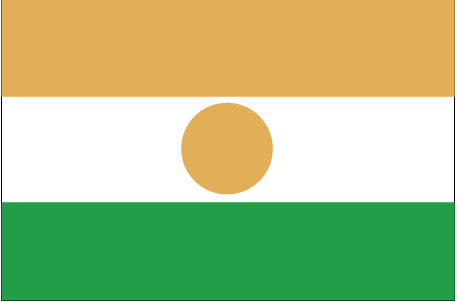
In September 2006, four weeks of torrential rains led to floods in Niger. United Nations humanitarian agencies rushed to provide emergency assistance, including food, clothes and bedding, to more than 15,000 people that were left homeless or otherwise injured by the floods. Relief agencies were concerned about the potential outbreak of diseases like cholera and malaria in the wake of the floods, as well as cattle losses and damage to local infrastructure. While the year 2006 hit Niger with floods, Niger faced an entirely different environmental disaster in 2004: drought & locusts that devastated agricultural production and intensified Niger’s food crisis. Locust infestations and drought not only affected the health of Nigeriens by impacting their crops and livestock, but they also affected the security and stability in the region. With scarce food resources and families on the verge of malnourishment and starvation, tensions rose as farmers and herdsmen struggled to survive. Newspaper headlines like ‘NIGER: 11 killed in clashes between farmers and Fulani herdsmen’ demonstrate how scarce resources can intensify ethnic conflicts.
Niger is the poorest country in the world. Niger is a dry, landlocked country along the Sahara desert where most of its 11.9 million people live off the land. Countries like Niger that are poor, situated in dry, desert areas, that are largely dependent on farming and livestock, and are most vulnerable to food shortages[1]. Even when the rainy season is good, more than half of the population does not have enough food due to the country's poor natural resource base and extremely low cereal yields.[2] The competition for Niger’s meager natural resources is the major cause for its’ ethnic conflicts.
 The
largest ethnic groups in Niger are the Hausa and the Djerma-Songhai. Both the
Hausa and the Djerma-Songhai are sedentary farmers who live in the arable,
southern tier. The remainder of the Nigerien people are nomadic or semi-nomadic,
and include the Fulani, Tuareg, Kanouri, and Toubou. With rapidly growing populations
and the consequent competition for meager natural resources, sedentary farmers
and nomadic peoples have increasingly come into conflict in recent years.[3]
As mentioned earlier, even in “optimal” conditions where there
is plenty of rainfall, more than half of the population does not have enough
food.
One can only imagine how dire the situation is with the combined onslaught
of drought and desert locusts.
The
largest ethnic groups in Niger are the Hausa and the Djerma-Songhai. Both the
Hausa and the Djerma-Songhai are sedentary farmers who live in the arable,
southern tier. The remainder of the Nigerien people are nomadic or semi-nomadic,
and include the Fulani, Tuareg, Kanouri, and Toubou. With rapidly growing populations
and the consequent competition for meager natural resources, sedentary farmers
and nomadic peoples have increasingly come into conflict in recent years.[3]
As mentioned earlier, even in “optimal” conditions where there
is plenty of rainfall, more than half of the population does not have enough
food.
One can only imagine how dire the situation is with the combined onslaught
of drought and desert locusts.
In 2004, the U.N. Food and Agriculture Organization warned that locust swarms threatened to wreak havoc in West Africa after exceptional rains were followed by periods of drought; it is precisely such conditions that allow locusts to flourish. The UN was correct in their estimations, and – amongst other West African countries - Niger suffered immense crop shortage due to droughts and locusts that left fields barren. Manomi Maïgomo has lived here in Kabima, Niger for a long time. It is difficult for him to remember how long he has lived there, as he counts his years in terms of rainy seasons: his memory wavers and he forgets.What he does remember is the unlucky day that plunged him and his family into desperation: it was in the middle of an August afternoon when "The sky turned black and we couldn't see the sun. The locusts came at two o'clock. They ate and when they had finished at 10 the next morning, they left.” He left his family and his home in the hope of earning a few cents elsewhere.[4]
The damage of the drought and locusts was so bad that in March of 2005, the World Bank announced that the ambassadors of seven African countries signed a series of agreements with the Bank’s International Development Association (IDA) for the Africa Emergency Locust Project. Beneficiary countries included Niger and put the anti-locust program into effect to limit the damage to future harvests.[5]
Description of Locusts
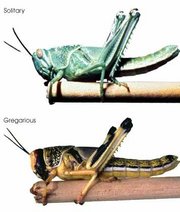 Locusts
have been known since ancient times, and are even mentioned in the Bible. According
to the Bible, locust plagues were sometimes used as agents of God's wrath against
those who opposed Him:
Locusts
have been known since ancient times, and are even mentioned in the Bible. According
to the Bible, locust plagues were sometimes used as agents of God's wrath against
those who opposed Him:
“ The LORD said
to Moses, ‘Raise your hand over the land of Egypt to bring on the locusts.
Let them cover the land and eat all the crops still left after the hailstorm.’ So
Moses raised his staff, and the LORD caused an east wind to blow all that day
and through the night. When morning arrived, the east wind had brought the locusts.
And the locusts swarmed over the land of Egypt from border to border. It was
the worst locust plague in Egyptian history, and there has never again been one
like it. For the locusts covered the surface of the whole country, making the
ground look black. They ate all the plants and all the fruit on the trees that
had survived the hailstorm. Not one green thing remained, neither tree nor plant,
throughout the land of Egypt.” --Exodus
10:12-10:15
Locust swarms can contain billions of insects, which pose a serious threat
to both crops and grazing land. A fascinating (and somewhat chilling) fact
is that “A swarm [of locusts] can munch the same amount in a day as
10 elephants, 25 camels or about 2,500 people.” [6] The term locust
refers to grasshoppers that gather in swarms to feed. The desert locust of
Africa
can take two different forms depending on environmental conditions. The non-threatening
green grasshoppers feed individually, but as food and water become abundant,
the green grasshoppers multiply and the next generation turn black and yellow.
The black and yellow locusts congregate into groups that can include more
than a billion insects whose swarms can fly up to 100 kilometers per day
and can bring crop damage of biblical proportions. [7]
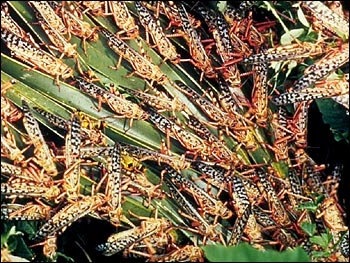 Interestingly
enough, up until 1921, it was thought that the Desert Locust was actually two
different species of locusts. Since then, a phase theory has
been developed to account for the sporadic appearance and disappearance of
locust swarms. According to the theory, a plague species has two phases: one
solitary and the other gregarious. When
there has been sufficient rain for a lot of locust eggs to hatch, forced physical
contact causes the insects' hind legs to rub up against each another. This
triggers both metabolic and behavioral changes that signal the insects'
transformation from solitary behaviour to gregarious behavior.The two phases
can be distinguished by differences in coloration, form, physiology, and behavior
of the species. As Desert Locusts
increase in number and become more crowded, they change their behavior from
that of acting as an individual (solitary) insect to that as acting as part
of a group (gregarious). While the solitary insect does no harm, the gregarious
insects can cause absolute havoc and devastation. As mentioned earlier, the
appearance of the locust also changes: A solitary locusts
adjusts
its coloration
to match
that
of its
surroundings while gregarious locusts are black and yellow (orange) in coloration.[8]
Interestingly
enough, up until 1921, it was thought that the Desert Locust was actually two
different species of locusts. Since then, a phase theory has
been developed to account for the sporadic appearance and disappearance of
locust swarms. According to the theory, a plague species has two phases: one
solitary and the other gregarious. When
there has been sufficient rain for a lot of locust eggs to hatch, forced physical
contact causes the insects' hind legs to rub up against each another. This
triggers both metabolic and behavioral changes that signal the insects'
transformation from solitary behaviour to gregarious behavior.The two phases
can be distinguished by differences in coloration, form, physiology, and behavior
of the species. As Desert Locusts
increase in number and become more crowded, they change their behavior from
that of acting as an individual (solitary) insect to that as acting as part
of a group (gregarious). While the solitary insect does no harm, the gregarious
insects can cause absolute havoc and devastation. As mentioned earlier, the
appearance of the locust also changes: A solitary locusts
adjusts
its coloration
to match
that
of its
surroundings while gregarious locusts are black and yellow (orange) in coloration.[8]
Violent conflict between herders and farmers in Africa have been the subject of various academic papers ever since the establishment of colonial rule in Africa, and have been characterised by scholars as either symbiotic, competitive or inherently conflictual. no matter how scholars may describe these tensions, competition and conflict over natural resources is omnipresent in Africa. Violent conflict between farmers and herders in Africa supposedly intensified since the droughts of the 1970s and 1980s, In Niger, historic conflicts occurred over access to fertile lands during the dry season. While the access to and control over key natural resources may have been the ultimate cause of conflicts between herders and farmers, the realignment of power brought about by colonial rule also affected and intensified the conflicts between the groups.[9] As mentioned earlier, the rapidly growing populations and the consequent competition for meager natural resources, along with recurring droughts and locust infestations, has led the farmers and herders in Niger into conflict historically, with conflicts continuing today.[10]
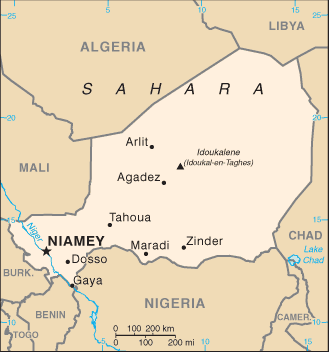
Continent: Africa |
Region: West Africa |
State: Niger |
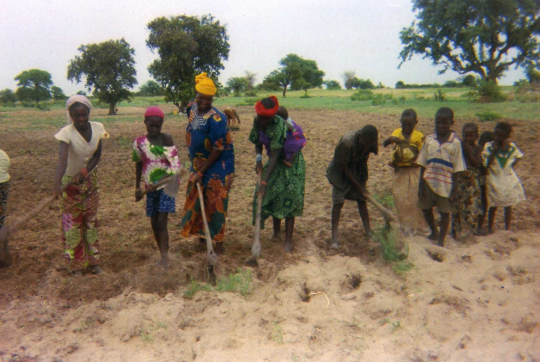
The sedentary farmers in Niger - the Hausa and the Djerma-Songhai - from the arable, southern tier and the herders - including the Fulani, Tuareg, Kanouri, and Toubou tribes - are the main actors in this conflict. The rapidly growing populations, the competition for meager natural resources, the recurring droughts and locust infestations, and the increased availability of firearms are all factors that lead to conflict between the two distinct groups.

As unfortunate as they may be, insect infestations and natural disasters are recurrent throughout history. The following are a few examples of plagues, with brief details on each.
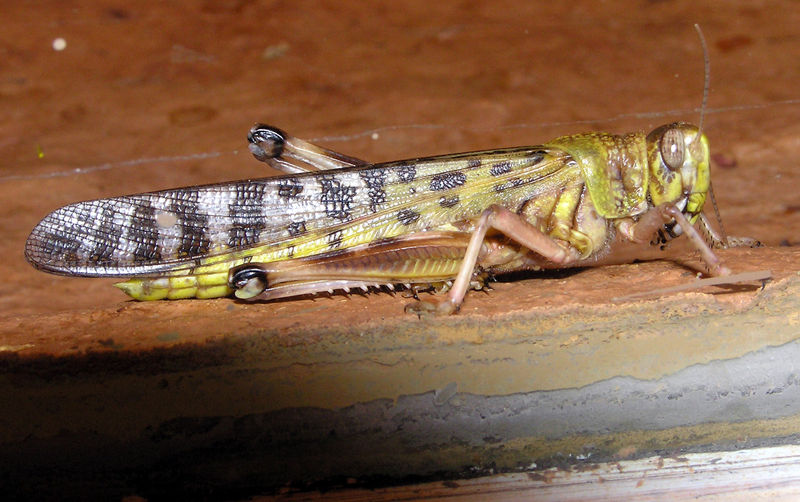 Examples
of Man versus Insect [11]:
Examples
of Man versus Insect [11]:
Date: 1300 B.C.
Type of Insect: Desert Locusts
Location: Egypt
DAMAGE: Locusts devoured fields
Date: 1733
Type of Insect: Brown Plant-hoppers
Location: Japan
Damage: Japanese crops were devastated and 12,000 people starved.
Date: 1874-1877
Type of Insect: Rocky Mountain Locusts
Location: Western United States
Damage: Record-breaking swarm was 1800 miles long.
Date: 1987-1989
Tupe of insect: Desert Locusts
Location: North Africa
Damage: Plague affected 28 countries and cost more than $300 million to control
Date: 2004
Type of Insect: Desert Locusts
Location: Niger
Damage: Niger suffered a crop shortage due to an invasion of locusts that left
fields barren. A drought quickly followed, which led to a food crisis in the
country.
Examples of Man Versus Nature 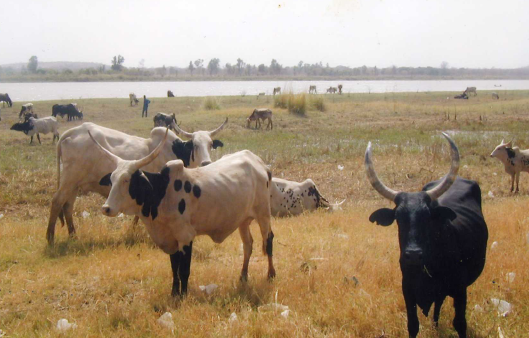
Date: 1930s
Type of Disaster: Dust Bowl
Location: Great Pkains, US
Damage: The agricultural devastation lengthened and intensified the Great Depression
whose effects were felt worldwide.
Date: 1931
Type of Disaster: Flood
Location: China
Damage: It is estimated to have killed between 850,000 and 4,000,000 people.
Date: 2004
Type of Disaster: Drought
Location: Niger
Damage: Food Shortages, famine and devastation.
Date: 2004
Type of Natural Disaster: Tsunami
Location: Indian Ocean, South and Southeast Asia
Damage: 229,866 persons lost, 186,983 dead and 42,883 missing.
Date: 2005
Type of Natural Disaster: Hurricane
Location: New Oeleans, US
Damage: Immense devastation along much of the north-central Gulf Coast of the
United States.
As can be seen from the evidence above, historically, natural disasters have resulted in increasingly serious economic and agricultural loss; locust infestations and drought in Niger are examples of natural disasters that not only affect humans but also have serious repercussions on the environment. Natural disasters are regarded by most as disasters due to natural forces --not human action. Yet some experts believe that Niger is now more vulnerable to natural disasters - like droughts and plagues – due to human pressures on the environment, including irrigation systems, tree-cutting and desertification. [12]
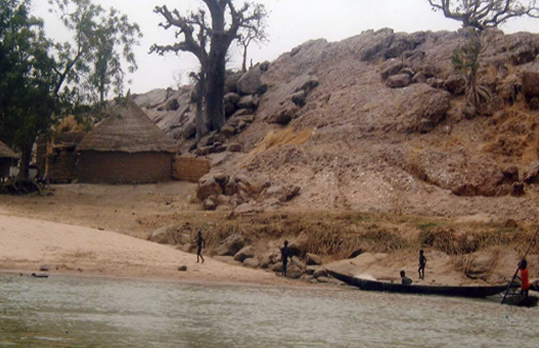 Agricultural
systems, as opposed to natural ecological systems, are man-made and thus are
particularly vulnerable to climatic change. The agricultural sector
in Niger contributes about 34.8% of the GDP and employs about 85% of the work
force [13], thus it can be inferred that agricultural systems in Niger are
particularly susceptible to natural disasters. The agricultural systems in
Niger are very
fragile because of their increasing and accumulated pressures. Pressure on
water resources is particularly important in Niger because the country supports
agricultural production, a large population, and its’ water use is relatively
higher than its’ water availability. Take, for example, the Niger River
(pictured above). Niger, along with Burkina Faso and Mali, is heavily dependent
on the water provided by the Niger River. Not only is water vital to agriculture
and
irrigation
in the region, but it also provides drinking water for people and livestock.
Faced with drought, Niger’s population obviously extracts large amounts
of water from the river, which in turn affects the ecosystem.[14]
Agricultural
systems, as opposed to natural ecological systems, are man-made and thus are
particularly vulnerable to climatic change. The agricultural sector
in Niger contributes about 34.8% of the GDP and employs about 85% of the work
force [13], thus it can be inferred that agricultural systems in Niger are
particularly susceptible to natural disasters. The agricultural systems in
Niger are very
fragile because of their increasing and accumulated pressures. Pressure on
water resources is particularly important in Niger because the country supports
agricultural production, a large population, and its’ water use is relatively
higher than its’ water availability. Take, for example, the Niger River
(pictured above). Niger, along with Burkina Faso and Mali, is heavily dependent
on the water provided by the Niger River. Not only is water vital to agriculture
and
irrigation
in the region, but it also provides drinking water for people and livestock.
Faced with drought, Niger’s population obviously extracts large amounts
of water from the river, which in turn affects the ecosystem.[14]
During times of drought, water is not the only dwindling resource. Jyrki Kakonen in his book ‘Perspectives on Environmental Conflict and International Politics’ notes that during drought spells, “the cutting of trees for charcoal and firewood is often intensified.” [15] If you are interested in reading more about the effects of charcoal production in Africa, please see the Charcoal Case. Tree cutting, whether for energy needs or construction needs, is another cause of erosion problems that affects the ecosystem. Trees (along with grasses, hedgerows, and shrubs) do more than provide food, energy, and animal fodder.[16] They also help “preserve soil fertility, prevent erosion, conserve water resources, check or counteract climate changes, and provide a habitat for wildlife.”[17] By cutting down large amounts of trees, Niger’s population is depleting the environment and putting excessive pressure on the land on which its livelihood rests. While this has no direct effect on locusts, it does indeed deplete the already scarce resources in Niger, which can be made even more scarce by locusts.
Alongside water availability and tree cutting, another important environmental problem related to drought and locust infestations is desertification. For a detailed explanation on desertification caused by humans, please refer to Andrew Furber’s case study on Niger Desertification causes desert-like conditions to spread to areas where such conditions would not normally exist, and causes a decline in the potential for food cultivation and livestock husbandry. It is caused by humans ("desertification" comes from Latin phrase desertus facere: to make into desert) through rapid population growth and increasing numbers of livestock that strain a region's carrying capacity. Drought and desertification are closely linked: years of water shortages and great rainfall variability make desertification more acute.[18]
 Nigeriens
are often blamed for environmental degradation through desertification, their
depleting agricultural systems, and the tree cutting that exhausts their
environment. But I would have to agree with Mohamid Salih when he notes: “the
cutting of wood for charcoal-making, fencing and house-building and extending
the grazing and cultivation of land are not matters of carelessness on the
part of poor peasants and pastoralists in underdeveloped countries, but a matter
of poor people in a continuous struggle to eke out a living in a situation
of absolute poverty and destitution.”[19]
Nigeriens
are often blamed for environmental degradation through desertification, their
depleting agricultural systems, and the tree cutting that exhausts their
environment. But I would have to agree with Mohamid Salih when he notes: “the
cutting of wood for charcoal-making, fencing and house-building and extending
the grazing and cultivation of land are not matters of carelessness on the
part of poor peasants and pastoralists in underdeveloped countries, but a matter
of poor people in a continuous struggle to eke out a living in a situation
of absolute poverty and destitution.”[19]
On a brighter note, in the Maradi district in southern Niger, farmers have
fought back and have
actually started reversing desertification. While there
are still droughts, the land is less eroded and more productive than in the
past because of such activities like switching from herding cattle to settled
farming, which is far less detrimental to the land. Such activities demonstrate
the importance of relying and building on local people’s
knowledge and practices, as external interventions sometimes undermine
local systems of decision-making and resource management.
Besides switching from herding cattle to settled farming, another innovative
project
in
Niger consists of
termites.The International Fund for Agricultural Development describes the termite
technique
as "digging holes some 15-20 cm deep and
using
the unearthed soil to build protective ridges around the hole.The hole bottoms
are
then covered with manure,which becomes a breeding ground for termites.The termites
bore through the hard-baked soil,producing a delicate network of tunnels.When
the
rains come,the holes and tunnels fill with water,and farmers plant millet or
sorghum
in them without having to toil."[20]
Below is a visual that may help you with understanding the situation in Niger.
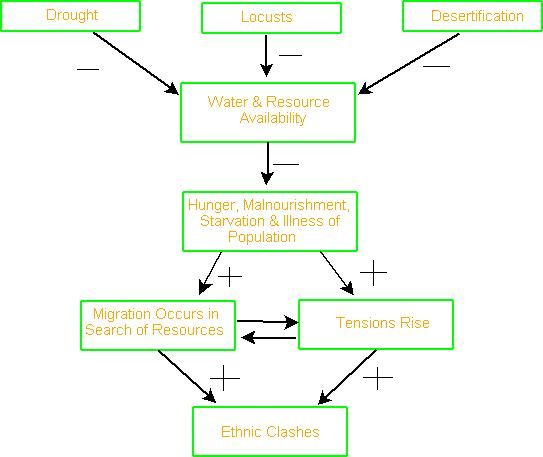
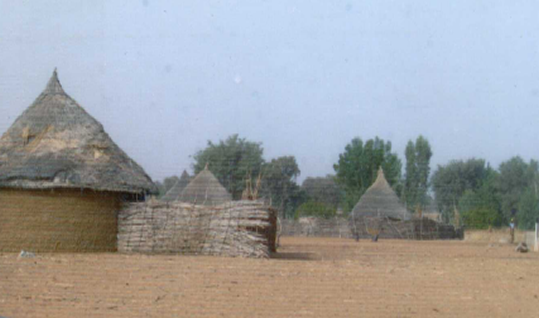 Niger
is a landlocked dessert area, and it is one of the hottest places in the world.
Only one-fifth of Niger is savanna, and thus only one-fifth of Niger
is suitable for livestock and (limited) agriculture.[21] Seeing as there is
such limited arable land, the demand or and ensuing pressure upon the land
and its
resources are alarmingly high in ‘normal’ conditions. These pressures
are naturally intensified at times of drought and locust infestations.
Niger
is a landlocked dessert area, and it is one of the hottest places in the world.
Only one-fifth of Niger is savanna, and thus only one-fifth of Niger
is suitable for livestock and (limited) agriculture.[21] Seeing as there is
such limited arable land, the demand or and ensuing pressure upon the land
and its
resources are alarmingly high in ‘normal’ conditions. These pressures
are naturally intensified at times of drought and locust infestations.
Locusts did not only affect Niger. Outbreaks first developed in the Fall of 2003 in northwestern Mauritania, northern Mali, Niger and northeastern Sudan as a result of good rainfall and breeding during the summer. The swarms of locusts then swept across West Africa, devouring crops in Senegal, Mauritania, Mali and Chad. While these latter countries were worst off, the countries that were reportedly affected by the 2004 outbreak included: Algeria, Burkina Faso, the Canary Islands, Cape Verde, Egypt, The Gambia, Guinea, Libyan Arab Jamahiriya, Morocco, Saudi Arabia, Sudan, Tunisia and Yemen. During plagues, Desert Locusts may spread over an enormous area of some “29 million square km, extending over or into parts of 60 countries. This is more than 20% of the total land surface of the world. During plagues, the Desert Locust has the potential to damage the livelihood of a tenth of the world's population.” [22] Similarly, the drought conditions were not limited to just Niger. Several other countries in Africa, that are equally arid, suffered from droughts as well. In 1987, Eugene M. Rasmussen from the National Meteorological Center pointed out that:
“Rain fluctuations in Africa during recent years are as follows: a) wet conditions throughout Africa during the 1950s, b) a severe pattern of drought (a situation where rain is below what is normally needed or expected for a crop and livestock production) during 1968-1973, with abnormally dry conditions prevailing throughout Africa except for a narrow equatorial strip, c) an easing of dry conditions during the remainder of the 1970s followed by a return to severe drought conditions over much of the continent during 1982-1984.”[23]
This latter paragraph demonstrates the weather patters and fluctuations in
Africa. Unfortunately for African countries and their populations, 2004 and
2005 were years of intense drought throughout the region, not to mention an
infestation of locusts.

Hunger and malnutrition are still the world's biggest killers, taking the lives of more people every year than AIDS, malaria and tuberculosis combined.[24] The level of conflict in Niger revolves around the issue of access to resources, and ensuing hunger and starvation. Agricultural production in 2004 was severely affected by locust infestations and drought in the northern regions of Niger. Following the locust infestations and the drought, various organizations reported evidence of key characteristics of a food crisis.[25] Such key characteristics included:
• Cereal prices increased rapidly
• Local food commodities were scarce
• People were eating seeds
• The price of livestock drops as people sell assets to buy food
• Large groups of men leave their villages much earlier than normal in
search of work
•
Herders take their cattle in search of pasture earlier than normal, causing
conflict between them and farmers
Locust infestations and drought not only affect the health of Nigeriens by
affecting their crops and livestock, but they also affect the security and
stability in the region. With scarce food resources and families on the verge
of malnourishment and starvation, tensions rise as farmers and herdsmen struggle
to survive. Headlines like ‘NIGER: 11 killed in clashes between farmers
and Fulani herdsmen’ demonstrate how scarce resources can intensify ethnic
conflicts. One of the bloodiest clashes occurred in 1991, when more than 100
people were killed in a dispute over grazing rights at Toda, in south central
Niger. In response to these clashes, government officials urge local cattle
herders and farmers to live together in peace and harmony.yet scarce resources
have the ability to set off disputes
and
deepen
conflict over and over again. .
The Food and Agriculture Organization described Niger’s situation in 2004 as the second-worst food crisis in its history, with thousands dead and up to a quarter of the population of 12 million people in need of food aid.[26] Jan Egeland, the U.N. Humanitarian chief, supported those figures and estimated that 2.5 million people in Niger were in desperate need of food, 800,000 of them children. It is obvious that the drought and the locusts both had severe effects on the Nigerien population, this the repercussions and fatality level due to environmental disasters is high. On the other hand, fatality level due to ethnic conflict itself is relatively low. Therefore, two different fatality levels are listed: one due to environmental disasters, the other due to ethnic clashes.
Furthermore, the conflict may intensify and thr fatality level may rise due to the current, dire situation in Chad and Darfur. As the security and humanitarian conditions in Chad and Darfur become worse, it is clear that there may be spill-over affect in neighboring countries. The first signs of unrest already occured in Niger, where farmers demanded that the government reinstate its plan to expel 150,000 Arab herders who migrated from Chad during the past generation. Darfur is a perfect example of where ethnic rivalry, government manipulation, and competition over resources can lead, and hopefully Niger - or other countries for that matter - will not follow in that direction.

12. Environment-Conflict Link and Dynamics: Indirect
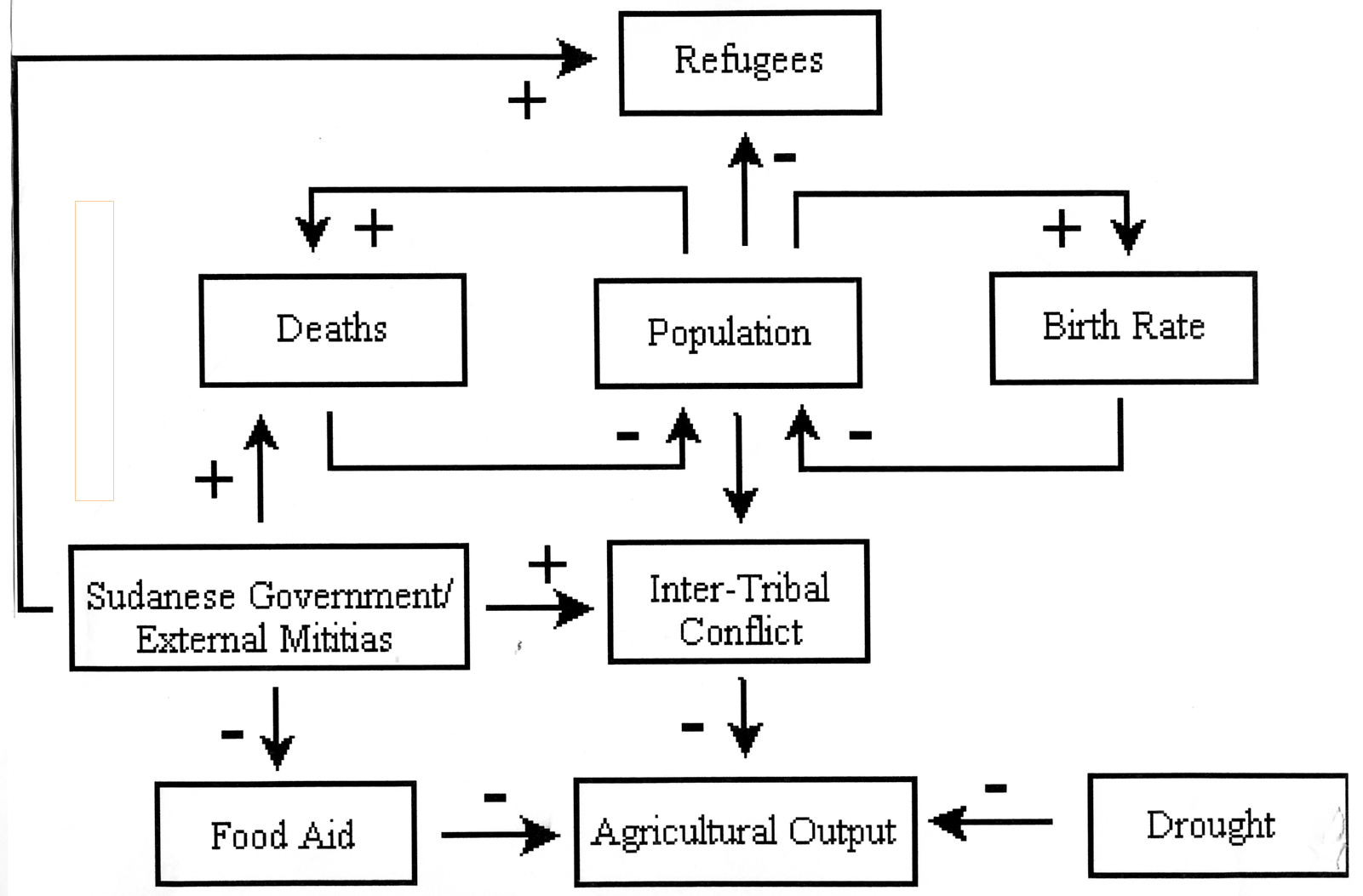
As has been stressed throughout this report, Niger is one of the poorest countries in the world with minimal government services and insufficient funds to develop its resource base. The largely agrarian and subsistence-based economy is not only affected by desertification, but it is also frequently disrupted by extended droughts and sometime plagued by locusts. Desertification, droughts and locusts all have an indirect affect on diminishing the already-scarce resources in Niger, which then leads to conflict between different ethnic groups within the Nigerien population.
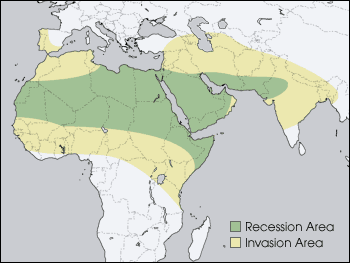 While the drought and locust infestation affected the West African region,
this case study focuses solely on the devastation in Niger. Drought and locysts,
along with desertification and chronic
poverty, is what led to the devastating food crisis in Niger, where Nigeriens
suffered from
severe food
insecurity and were in desperate need of aid.
While the drought and locust infestation affected the West African region,
this case study focuses solely on the devastation in Niger. Drought and locysts,
along with desertification and chronic
poverty, is what led to the devastating food crisis in Niger, where Nigeriens
suffered from
severe food
insecurity and were in desperate need of aid.
Even though drought and locusts have not (yet) affected Niger’s crops this year, there is still absolute poverty in the country, there are still hundreds of children who die from malnutrition and hunger, and desertification and environmental degradation still devastate land and water resources, thereby increasing Nigeriens’ vulnerability to food shortages. These latter problems must be addressed. While there is no magic solution, the following is a list of factors that could help Niger’s dire situation:
• Better early warning analysis and action. Organizations like the ‘Humanitarian
Early Warning Service’ issue ‘Situation Updates’ on locusts
(http://www.hewsweb.org/locust/), as does the FAO Locust Group. Through these
sites, it is possible to determine the threat od locusts and to start controlling
them.
•
Enough advance funding to allow governments, the UN and non-governmental organizations
to take adequate preparatory measures and deploy personnel with greater speed.
•
Greater emphasis on prevention: “Prevention is always less expensive
than cure.” Some steps have already been taken. For example, researchers
say that Niger has recently begun to go against desertification by planting
trees and preserving natural vegetation; teams of workers have already rehabilitated
three million hectares of severely degraded land.[27]
•
Build-up of the region's existing strengths and structures to promote cooperation
between African countries, along with bilateral and multilateral donors.[28]

Just for Fun: Locust Recipes [29]
•
Remove the wings and hindlegs of the locusts, and boil the bodies in water
until soft. Add salt.
•
Slit the abdomen of the adult locust lengthwise and stuff a peanut inside.
Lightly grill the locusts in a pan, adding oil and salt to taste.
• Place locusts on a skewer and grill while turning (to avoid burning
the locusts) until they become golden brown.
• Case No.27 – Niger: This case revolves around the Tuareg and Fulani revolts in Niger, and explains how desertification impacts and intensifies the conflict between different groups of Nomads. It also examines the ‘Pulse Model’ as a historical explanation for tension in Niger; the pulse model is used by archeologists to describe the tendency of the Sahara desert to "move" and how this impacts societies and theit habitat. Niger Link
• Case No.151 – Tuareg: This case discusses the causes of desertification, and explores the impact of desertification on the Tuareg conflict. The Tuareg conflict in Mali and Niger took place in the 1990s, and involved nomadic people who were impacted by desertification and ensuing habitat loss. Tuareg Link
• No. 147 – Plague: The Black Death reached the shores of Europe in 1348 via rats that were carried on merchant ships. In 1630, the Venetian Republic, again ravaged by another onset of the plague, began its descent towards its ultimate downfall in 1797 that was led by the Ottoman Turks and completed by Napoleon Bonaparte. Plague Link
• No.79 - Diamond-SL: A violent civil war rages in Sierra Leone The Revolutionary United Front (RUF) wages a brutal guerrilla campaign throughout Sierra Leone, a campaign in which the deliberate and systematic mutilation of civilians is commonplace. This case focuses on the role of the diamond trade upon the conflict: control of the diamond producing regions of Sierra Leone is the primary source of revenue for the RUF.Diamond Link
• No.43 - Biafra: Nigeria is a federation of states that are segregated by 3 major ethnic groups: the Ibo, Hausa/Fulani and Yoruba; these ethnic groups were brought together via European efforts to divide Africa among themselves. Tensions between these ethnic groups revolved around access to oil reserves in the southern Niger Delta and led to the Biafran war, which lasted from 1967-1970. Biafra Link
• No.64 - Ogonioil: Oil has been an important part of the Nigerian economy since vast reserves of petroleum were discovered in Nigeria in the 1950s. Shell operates many of its oil facilities in the oil-rich Delta region of Nigeria, and the Ogonis (an ethnic group that predominate in the Delta region) have protested that Shell's oil production has devastated the local environment and destroyed the economic viability of the region for local farmers and producers. Ogonioil Link
• No.23 – Rwanda: Environmental scarcity was just one of the many aggravating factors that impacted the conflict in Rwanda in 1994. Rwanda's geography and demography makes it susceptible to certain types of environmental problems; for example, the degradation of Rwanda's natural resource base is closely tied to pressure exerted on a limited arable land mass by a rapidly growing population. Rwanda Link
•No.88 - Congo-coltan: The conflict in the Democratic Republic of Congo
revolves around the struggle for power over the country's resource of coltan.
Coltan is a key element in cell phones, computer chips, nuclear reactors, and
PlayStations.
Congo
Coltan Link
• No. 46 - Kikuyu: In 1993, violence erupted in the Narok district of
Kenya's Rift Valley province when Maasai morans (warriors) attacked and massacred
immigrant Kikuyu settlers. Environmental factors played a central role as a
water catchment area had been found in the district, whereby the inhabitants
(which were mostly Kikuyus) were forced to leave their habitat.
Kikuyu
Link
• No. 30 – Angola: The Republic of Angola has been at war for over 35 years. Angola has the potential to be a wealthy developed African nation because it poseesses large petroleum and diamond reserves, yet –unfortunately – it has been at war for over 35 years over natural resources. This case revolves around the diamond mines in the Lunda provinces, which finance guerrilla struggle against the government, and have impacted habitat loss in the area. Angola Link
Cited Sources
[1] World
Bank. ‘Hunger in Niger’ Acccessed on 1 October 2006
[2] ReliefWeb. ‘Food
Crisis in Niger.’ Accessed
on 1 October 2006
[3] Nation
by Nation. ‘Niger Population.’ Accessed on 1 October 2006
[4] CARE. ‘Locusts
and drought destroyed crops and hope across Niger.’ Accessed
on 1 October 2006 at
[5] World
Bank. ‘World Bank Supports Locust Control.’ Accessed on
1
October
2006 at
[6] ReliefWeb . ‘West Africa Locusts hit Chad.’ Accessed on 1 October
2006 at
[7] The
Hindu. ‘Locusts Sweep Across Africa.’ Accessed on 28 September
2006
[8] Britannica
Encyclopedia. ‘Locusts’ Accessed on 22 October
2006
[9] UMSL. ‘Background
Notes: Niger.’ Accessed
on 5 October 2006
[10] H. Karim, Increasing Violent Conflict between Herders and Farmers in Africa,
Development Policy Review; Dec99, Vol. 17 Issue 4, p397
[11] Jill Davis, 'When
Bugs Go Bad,' Popular Mechanics Jan 2005, Vol. 182, Issue 1, p27
[12] UN
Information Centre in Nairobi. ‘The UN in Africa.’ Accessed
on
2 October 2006
[13] Columbia
University. ‘Republic of Niger.’ Accessed on 3 October
2006
[14] Afrol. ‘River
Niger to be Saved.’ Accessed
on 23 October 2006
[15] J. Kakonen, (ed.) Perspectives on Environmental Conflict and International
Relations.
(London: Pinter, 1992) 120
[16] Global
Environment Summary. ‘Project Executive Summary: Niger.’ Accessed
on 23 September 2006
[17] ISNAR. ‘The
Sahel.’ Accessed
on 3 October 2006
[18] ISNAR. ‘The
Sahel.’ Accessed
on 3 October 2006
[19] Kakonen page 118
[20] Dryland
Techniques
[21] CIA
[22] FAO
[23] Kakonen 119
[24] UN. ‘UN Agencies Urge G8 Leaders to Step up to the Plate.’ Accessed
on 3 October 2006
[25] Africa
Focus. ‘Niger: Background to Famine. Accessed on 28 September
2006
[26] ReliefWeb
[27] AllAfrica. ‘Tide Turning On Desertification.’ Accessed
on 11 October 2006
[28] UN. ‘Africa cannot grow or be free on an empty stomach.’ Accessed
on 11 October 2006
[29] FAO ‘Frequently Asked Question.’ Accessed
on 28 September 2006
